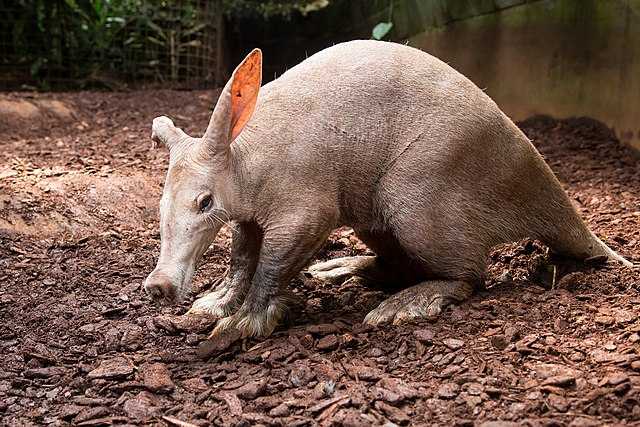The aardvark is a medium-sized, burrowing, nocturnal mammal native to Africa. It is the only living species of the order Tubulidentata, although other prehistoric species and genera of Tubulidentata are known.
Trophic level: Carnivorous Encyclopedia of Life
Scientific name: Orycteropus afer
Gestation period: 213 days
Length: 100 – 130 cm (Adult, Without Tail)
Conservation status: Least Concern Encyclopedia of Life
Mass: 40 – 65 kg (Adult)
Family: Orycteropodidae

List of facts
The aardvark is a medium-sized, burrowing, nocturnal mammal native to Africa
The aardvark is found over much of the southern two-thirds of the African continent
A nocturnal feeder, it eats ants and termites, which it will dig out of their hills using its sharp claws and powerful legs
An aardvark can eat 50,000 ants in one meal.
The name “aardvark” is Afrikaans
The aardvark is sometimes colloquially called the “African ant bear”, “anteater”, or the “Cape anteater” after the Cape of Good Hope.
The name comes from earlier Afrikaans erdvark and means “earth pig” or “ground pig”, because of its burrowing habits
The closest living relatives of the aardvark are the elephant shrews, tenrecidae, and golden moles
Aardvarks teeth are lined with fine upright tubes and have no roots or enamel.
Baby aardvarks are born with front teeth that fall out and never grow back.
An aardvark’s weight is typically between 60 and 80 kilograms
An aardvark’s length is usually between 105 and 130 centimetres
They have a sticky 45cm tongue
It is estimated to be able to run at speeds of which is around 38-42 km/h
The aardvark is pale yellowish-gray in color and often stained reddish-brown by soil.
They spend the daylight hours in dark burrows to avoid the heat of the day
They have tough skin that protects them from pests, and their large, flappy ears help them stay cool by acting as heat sinks.
They have been documented as high as 3,200 metres in Ethiopia.
Aardvarks live for up to 23 years in captivity
The aardvark is nocturnal and is a solitary creature
the only fruit eaten by aardvarks is the aardvark cucumbe
An aardvark forages over a considerable home range encompassing 10 to 30 kilometres
They avoid eating the African driver ant and red ants
Lions, hyenas, leopards and African wild dogs all prey on aardvarks
Aardvarks will occasionally stand, and even take a step or two, on their hind legs
The aardvark is known to be a good swimmer and has been witnessed successfully swimming in strong currents
The aardvark is a quiet animal but it does make soft grunting sounds as it forages and loud grunts as it makes for its tunnel entrance
An aardvark can dig a yard of tunnel in about five minutes
Aardvarks pair only during the breeding season
After a gestation period of seven months, one cub weighing around 1.7–1.9 kilograms is born during May–July
The first zoo to have an aardvark was London Zoo in 1869
An aardvark features as the antagonist in the cartoon The Ant and the Aardvark
The fighter-bomber F-111/FB-111 was nicknamed the Aardvark because of its long nose resembling the animal
